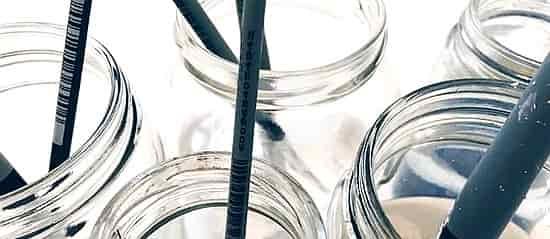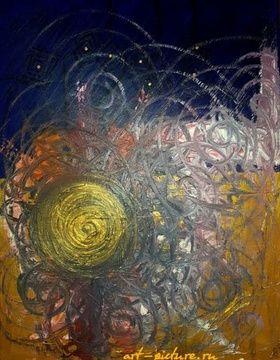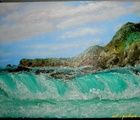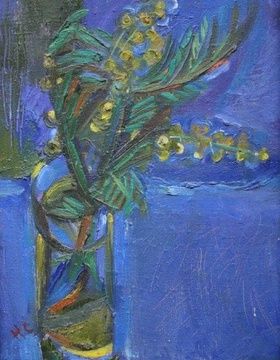
Масла, имеющие применение в живописи, по своему составу и назначению делятся на две группы. К первой относятся так называемые жирные высыхающие масла, получаемые из семян различных растений и относящиеся к жирам растительного происхождения, таковы льняное, маковое, ореховое и другие подобные им масла.
Во вторую группу входят масла различного происхождения, не принадлежащие к жирам, носящие название эфирных масел.
Жирные высыхающие масла имеют способность обращаться на воздухе в твердые вещества, что и дает возможность пользоваться ими как связующими веществами красок в масляной живописи и в малярном деле. На основании этого они и названы высыхающими маслами, в отличие от целого ряда других масел растительного же происхождения, которые или совершенно не проявляют этой способности в условиях живописной практики, или же проявляют ее лишь отчасти.
Все растительные жирные масла могут быть подразделены на высыхающие, полувысыхающие и невысыхающие. К высыхающим жирным маслам относятся: льняное, маковое, ореховое, конопляное, масло белой акации, растения лялеманции, масло сосновых и еловых семян, бузины, древесное (тунговое), перилловое, нигеровое.
К полувысыхающим относятся: хлопковое, подсолнечное, маисовое, кретоновое, рапсовое, сезамное, масло липового дерева и др. К невысыхающим - миндальное, касторовое, оливковое, кокосовое, пальмовое, фисташковое и многие другие.
Животные жиры в большинстве своем на воздухе не твердеют; исключением в этом отношении являются лишь ворвань (жидкий жир, добываемый из сала китов, тюленей и др)и рыбий жир, которые обладают этой способностью и потому нередко применяются для фальсификации высыхающих жирных масел.
Наиболее популярными в живописи жирными высыхающими маслами являются: льняное, ореховое и маковое масла.
Масла эти, подобно прочим растительным жирным маслам, представляют собой нелетучие бесцветные или окрашенные более или менее густые жидкости, которые не смешиваются с водой и не растворяются в ней, но, будучи легче воды, плавают поверх нее. Они с трудом растворяются в спирту, легко - в эфире, сероуглероде, хлороформе и в эфирных маслах.
Растительные жирные масла, как и жиры животного происхождения, состоят из углерода, водорода и кислорода. Они представляют сложные химические соединения, в которых важнейшими составными элементами являются соединения животных кислот с глицерином, на основании чего они и носят название глицеридов.
Глицериды эти при известных условиях способны образовать мыло и освобождать глицерин: на этом основании жирные масла носят название также омыляющихся масел. Эфирные масла относятся к неомыляющимся маслам. Представители этого вида масел по своему составу принадлежат главным образом к углеводородам. Одни из них улетучиваются на воздухе без остатка; другие же улетучиваются отчасти и отчасти окисляются, осмоляясь и образуя твердые вещества.
К маслам, улетучивающимся без остатка, относятся продукты, добываемые из нефти и каменноугольного дегтя. Таковы различные виды керосина, бензина, бензол, толуол, ксилол, тетралин и декалин. Большинство из них принадлежит к веществам, химически мало активным.
Эфирные масла, к которым относятся скипидары (французский, русский и др.), масла копайского бальзама, копаловое и янтарное масла, отчасти улетучиваются, отчасти окисляются, т. е. осмоляются, причем образуются в большем или меньшем количестве твердые вещества. Они представляют собой так называемые терпены - вещества химически активные. К эфирным маслам причисляются также масла, представляющие по химическому составу смесь углеводородов ряда терпенов с некоторыми кислородными соединениями. Таковыми являются: розмариновое, спиковое, лавендуловое, гвоздичное масла и масло бальзама элеми.
Масла и процесс их затвердевания
Масла эти получаются выжиманием семян льна и мака. Семена, подвергающиеся выжиманию, нагреваются до известной температуры или же выжимаются холодными.
Масла, получаемые горячим прессованием, т. е. с нагреванием "мезги" (измельченных семян), приобретают более темную окраску и содержат в себе большое количество посторонних примесей; масла же, выжатые холодным способом, значительно светлее и содержат меньшее количество их. К посторонним веществам, встречающимся в свежевыжатых маслах, относятся: слизь, крахмалистые и белковые вещества, соли неорганического происхождения, красящие начала, целлюлоза.
Все названные примеси в масле ухудшают его состав, портят его цвет, способствуют его прогорканию и замедляют его высыхание. Масла в чистом виде не имеют ни вкуса, ни запаха и не способны подвергаться порче. Для целей живописи наиболее пригодными поэтому являются масла, выжатые холодным прессованием и притом из сухих семян. На практике, однако, чаще применяется прессование с нагреванием мезги. При длительном отстаивании масел посторонние примеси, заключающиеся в них, оседают на дно сосуда, и масла становятся свободными от них. Таким образом, качество масел с годами улучшается.

Высыхающие жирные масла способны обращаться при соприкосновении с воздухом в твердые вещества, притом в достаточно короткий промежуток времени, почему они и применяются с давних пор для целей живописи и окраски; что касается сущности названного явления, то научное объяснение его началось лишь в позднейшее время.
Процесс высыхания растительных жирных масел, таким образом, значительно отличается от высыхания клеевых растворов или спиртовых лаков, где сущность процесса затвердевания заключается лишь в испарении воды и спирта и представляет собой очень сложный процесс, в котором принимают участие и химические и физические явления.
Затвердевание жирных масел сопровождается, с одной стороны, образованием летучих элементов, присутствие которых в воздухе, где находится свежая масляная краска, узнается по характерному запаху некоторых из них, хорошо знакомому каждому художнику; с другой-увеличением объема, а также веса масел. (Открытие этого важного явления принадлежит русскому ученому профессору физики Ф. Петрушевскому) . В первом периоде затвердевания масла прибыль в весе превышает потерю, в дальнейшем же длительном периоде происходит лишь уменьшение веса и объема его, вследствие чего высохший слой масла подвергается сжиманию и натяжению, под влиянием которых и происходит образование трещин в слоях масляной живописи.
При затвердевании масел и масляных красок на поверхности их образуется пленка, которая с трудом пропускает воздух, почему процесс сквозного просыхания слоя задерживается на долгое время. Масляная краска во всех условиях просыхает лучше в глубине ее слоя, чем слой одного масла, причем многие из красок энергично содействуют процессу затвердевания масел, например краски свинцового происхождения. Высыхание масла и масляных красок представляет весьма длительный процесс.
Живописцы различают в нем три момента:
- подсыхание масла, при котором на поверхности Слоя образуется пленка, дающая отлип;
- засыхание масла, когда наблюдается исчезание отлипа и образование твердой поверхности и
- полное сквозное затвердение масляного слоя.
Так, льняное масло, например, подсыхает в 3-6 дней, засыхает в 60 дней и затвердевает во всей толще слоя в 2 года.
По истечении двух лет от начала затвердевания краски сжатие ее хотя и не достигает еще предела, но становится почти незаметным. Уменьшение в объеме краски за 2 года, по проф. Ф. Петрушевскому, равняется от1/20 до1/4 прежнего объема и даже несколько больше. Краска сжимается тем значительнее, чем больше в нее было введено масла. Происхождение масла имеет в данном случае также большое значение, так как степень сжимания у различных масел, как показал опыт, различна.
При различных условиях процесс этот то ускоряется, то замедляется. Опыт показал, что свет, температура, сухость и влажность воздуха оказывают большое влияние на ускорение и замедление высыхания масла, но кроме них имеются и другие факторы, действующие в таком же направлении.
Свет играет весьма важную роль в процессе высыхания масел, причем при отсутствии света высыхание почти приостанавливается. Так, масло, сохнувшее на свету 6 дней, высохло в темноте в 66 дней. Особенно энергично действуют в этом случае прямые солнечные лучи, так как здесь имеет большое значение и теплота их. Действительно, для высыхания масляной окраски на солнечном свету требуется от половины до одной трети того времени, которое необходимо для высыхания ее же в тени. Наиболее активными лучами солнца являются ультрафиолетовые лучи, которые оказывают на ускорение высыхания масел не меньшее действие, чем действие так называемых "сикативов".
При длительном просыхании масляных красок под действием прямых солнечных лучей масляный слой может пострадать.
Как велико значение температуры воздуха для высыхания масел, об этом можно судить по следующим данным. Льняное масло при 25-28 гр. Ц; высыхает уже скорее, чем при 15-18 гр. Ц; со значительным же повышением температуры процесс высыхания особенно ускоряется. Так, по Вегеру, масло, высыхавшее зимой при комнатной температуре в 5-7 дней и летом в 3-4 дня, высыхало при 50 гр. Ц в темном сушильном шкапу в течение 12 часов, при температуре в 95 гр. Ц - приблизительно в течение 1 часа, а при 120 гр. Ц - в 30 минут. Масло, содержавшее марганцовый сикатив и высыхавшее при комнатной температуре в течение 14 часов, при 95 гр. Ц высыхало в 30-40 минут, а при 120 гр. Ц - в 15-20 минут.
Холод задерживает высыхание масел, равно как я большой процент влаги, содержащейся в воздухе (в дождливое время и в сыром помещении); нормальная же влажность воздуха благоприятно отзывается на процессе, так как масло одновременно с кислородом поглощает из воздуха и некоторое количество воды, необходимое для нормального хода высыхания, действие которой в процессе высыхания идет рука об руку с действием кислорода. Из сказанного следует, что высыхание масла в слишком сухом воздухе хотя и протекает быстро, но идет ненормально, так как в этом случае наблюдается большая потеря в веществе масла вследствие образования большого количества газообразных продуктов расщепления масла. При высыхании же масла в воздухе, насыщенном водяными парами, получается набухшая пленка с большим содержанием воды, которая при полном высыхании покрывается трещинами.
К веществам, ускоряющим высыхание масел, принадлежат известного состава краски, а также специальные препараты, именующиеся сикативами, которые содействуют поглощению маслом кислорода. Задерживают и замедляют процесс высыхания главным образом вода и слизь, содержащиеся в маслах, и некоторые эфирные масла, вводимые в жирные масла, так как эти последние сами нуждаются в кислороде для своего высыхания и таким образом препятствуют поглощению его жирным маслом. Кроме того, определенного состава краски также имеют свойство замедлять процесс высыхания. На ускорение и замедление процесса высыхания влияет также и материал, который покрывается маслом или масляной краской. Так, на поверхности свинца масло и масляная краска сохнут скорее, нежели на других металлах; на дереве сохнут медленней, чем на металлах. Позднейшие изучения растительных жирных масел выяснили, что и масла, относящиеся к разряду масел невысыхающих, будучи поставлены в особые условия, также затвердевают. Оливковое масло, например, будучи нанесенным на свинцовую пластинку, получает способность высыхать, на что, однако, требуется несколько месяцев. Затвердевшее масло, представляющее собой гибкое, эластичное вещество, названное линоксином, постепенно (по мере уменьшения в весе и объеме) теряет свою эластичность, вследствие чего старая масляная живопись делается хрупкой и ломкой.
Засохшее масло при полном отвердении нерастворимо в воде, с трудом растворимо в эфире, бензине и других эфирных маслах. Свежезасохшее масло представляет собой не сухое вещество, а жидко-твердое. По своему составу и строению оно может частично размываться водой, если краска, с которой масло стерто, не содействует ее закреплению. Так теряются масляные покраски на открытом воздухе. Это происходит не только вследствие отхода улетучивающихся продуктов высыхания масла, но также благодаря унесению растворимых продуктов водою. Затвердевшие пленки масла иногда вновь становятся мягкими и дают отлип. Подобное размягчение слоя после высыхания масла наблюдается главным образом у макового, орехового, подсолнечного масел и очень редко у льняного масла. На свету и в сухом воздухе пленки вновь становятся твердыми и теряют отлип.
Как долго длится процесс высыхания масляных красок с теми весовыми и объемными изменениями, которые наблюдаются при нем, в слоях живописи? Наступает ли в конце концов момент полного его затишья или же он идет беспрерывно, приводя в конечном результате слои масляной живописи в полное разрушение? Вот вопросы, разрешение которых представляет особый интерес для живописца, так как они непосредственно связаны с вопросом долговечности масляной живописи.
Разбирая их, проф. Ф. Петрушевский склонялся к тому же мнению, которого придерживались на этот счет и другие ученые, его современники, а именно, что химические процессы, про текающие в слоях масляной живописи и ведущие к ее разрушению, продолжаются беспрерывно. "Совершенно высохшая на вид масляная картина, говорит Ф. Петрушевский, продолжает окисляться до тех пор, пока не сделается рассыпчатой" (Ф. Петрушевский, Краски и живопись, 1891. стр. 85.).
Позднейшие исследования процесса затвердевания жирных масел не подтверждают, однако, этой теории. Не подтверждает ее и хорошая сохранность многих старинных живописных произведений, исполненных на одном масле. Современные исследователи вопроса полагают, что химические процессы, происходящие при высыхании в слоях масла и масляных красок, имеют место лишь в периоде затвердевания названных слоев; в дальнейшем же процессе наблюдаются лишь физические явления. Хрупкость и дряблость слоя живописи является следствием этих физических процессов.
Попутно с затвердеванием масла и изменением его химического состава наступает помутнение его прозрачного слоя, медленное пожелтение и потемнение, сначала лишь поверхностное, переходящее позднее, через большой промежуток времени, в потемнение во всей толще масляного слоя. Это изменение цвета масла происходит при различных условиях и различных маслах в различной степени. Лучшими маслами для живописи считаются льняное, маковое и ореховое; наибольшей популярностью из них пользуются льняное и маковое.


























